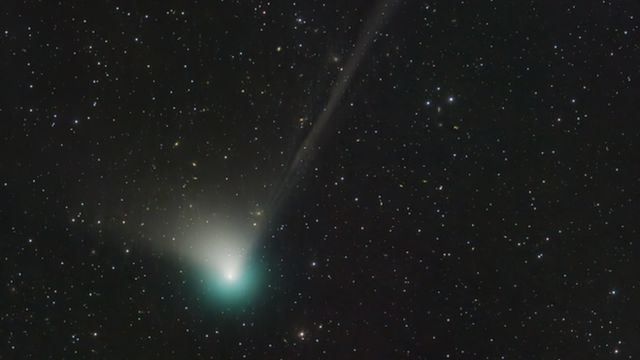A newly discovered comet will make its closest approach to our planet on Wednesday.
Astronomers say the object's journey toward us took around 50,000 years.
Photographs captured by astronomers show a distinct green hue around the body of the comet.
But those expecting a brilliant streak of emerald in the sky will be disappointed. Its brightness is right at the threshold of what is visible to the naked eye.
"You might have seen these reports saying we're going to get this bright green object lighting up the sky," says Dr Robert Massey, deputy executive director of the Royal Astronomical Society.
"Sadly, that's not going to be anything like the case."
However, away from light pollution and below dark skies, you might be able to see a smudge in the sky - if you know what you're looking for.
Would-be stargazers have a better chance of spotting it using binoculars, in which it will appear as a faint white blur.
"Even a small pair of binoculars will help you find it," says Massey.
Comets are mostly composed of ice and dust. As they approach the Sun, the ice is vaporised and the dust shaken off to create the signature long tail.
"If you're lucky, you'll see a hint of the tail coming off it, so it'll look more like a classic comet," says Massey.
Astronomers discovered the comet C/2022 E3 (ZTF) last March at the Palomar Observatory in California.
It has been visible to those in the Northern Hemisphere through binoculars for the past few weeks.
But it will make its closest approach to Earth at around 41 million km (26 million miles) away this Wednesday.
The object originates in the Oort cloud, a collection of icy bodies at the edge of the Solar System.
To find it, Massey suggests first searching for the pole star, which is always in the same place in the sky.
You can identify the pole star by looking directly north and locating a star that hangs distinctly by itself.
You can then use free planetarium software online to determine where the comet will be moving in relation to the pole star on the night you're looking at it.
The best time to view it will be in the early hours of Thursday morning when the Moon has set.
At that time the comet should appear just to the right of the pole star.
A green appearance for comets is not uncommon and is usually the result of breakdown of a reactive molecule called dicarbon - two carbon atoms joined together by a double bond.
Such colour is better picked up by digital cameras, which are more sensitive to colour.
The comet will not match the spectacle of the 2020 Comet NEOWISE - the brightest comet visible from the Northern Hemisphere since 1997.
But the Planetary Society said "an opportunity to see it will only come once in a lifetime".

Comments
Post a Comment